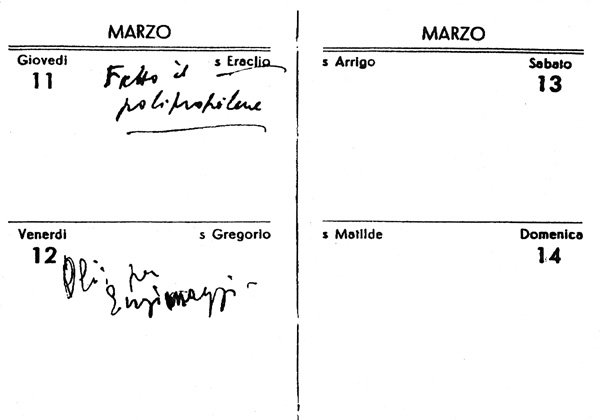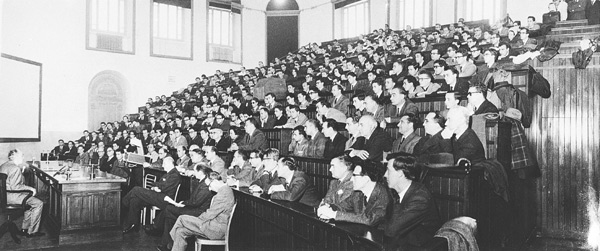History is written with a pencil. On Thursday 11 March 1954, chemical engineer Giulio Natta wrote the following note in his diary: "Made polypropylene"We turn the pages of the years and arrive at 1963, when during a holiday in Sanremo, Natta received news of considerable importance for the timetable of his life: an official announcement from the Swedish Royal Academy. On 5 November 1963, the headline of the daily paper Corriere Lombardo was: 'Nobel Prize in Chemistry awarded to Natta'. A little below it reads: ‘He is from Liguria, but has lived in Milan for many years, where he heads the Institute of Industrial Chemistry at the Politecnico. He has received the highest recognition for his discoveries in the field of plastics’.

On 10 December 1963, Gustav VI Adolf, King of Sweden, addressed Giulio Natta during the Nobel Prize award ceremony:
«The Royal Swedish Academy of Natural Sciences wished to show its appreciation by awarding you, Professor, the Nobel Prize. I would also like to express the Academy's admiration for the intensity with which you, Professor, despite certain difficulties, have persisted in your research».
The difficulties mentioned were due to his Parkinson's diseasewhich was diagnosed in 1956. Photographs from that period show him descending the stairs of an aeroplane with his wife Rosita, married in 1935, a literature graduate. It is to her that we owe the suggestion of a name of Greek origin for her husband's discovery: isotactic polypropylene.
In one of the many television reports that came out during that period, Natta is sitting at his desk and flipping through the telegrams of congratulations for the prize while an off-screen voice comments: ‘An unusually kind note in the scientist's study’. The camera frames a vase filled with roses, the petals coloured black, white and red, ‘It is a tribute from the students of the department of industrial chemistry in Milan to their professor, a Nobel Prize winner for inventing a new material, never seen before in the natural world. It is polymer whose molecules have the same order as things have in nature'.

Let's take a step back in this almanac of the years and head to May 1952, when the Achema chemical industry conference was held in Frankfurt. Karl Ziegler announced that he had discovered a new reaction between ethylene and aluminium. Among those attending the conference was Giulio Natta, who later tried to polymerise polypropylene with the same catalyst, despite Ziegler's negative opinion. The rest is history, written in pencil on that Thursday, 11 March 1954: ‘Made polypropylene’.
«We are Natta's students», say Alumni Mario Iavarone and Mario Garassino today, who are from the Natta School. «We chose the Politecnico because he was there. And because the Politecnico is not just a university, it is the Politecnico, it is a true institution. In Italy there have been twenty Nobel Prizes so far and Natta is still the only chemical engineer to have won it. The most important message he left us is not just an insight into chemistry, but also to the idea of work itself».

Iavarone has a clear memory:
«I see him behind the desk, behind him the blackboard, the chalk in his hand. And on that blackboard he would construct an image, illustrating the appeal of rationality, of bringing something to life with the power of the mind. Most problems, he seemed to suggest, are new problems, and he taught us how to solve them methodically: by rationalising them, setting objectives and tackling them. And so those marks on the blackboard became a reality. I believe that the value of the Nobel Prize is also closely related to the people he was able to involve».
Paolo Centola, who at the age of just over twenty had the honour of being involved with Natta himself in writing the book ‘Principi della chimica industriale volume 2’ (Principles of Industrial Chemistry Volume 2), describes him as follows: «Natta was not just a researcher, he was like an orchestra conductor. And he had chosen his musicians so that they all played well: they were first violins, strings, trumpets.
In the book “Giulio Natta, l’uomo e lo scienziato”, (Giulio Natta, the man and the scientist), his daughter Franca recalled: : «The young assistants were in the house until late at night. I still remember the lamp lit on a thick walnut table in front of a 15th-century bookcase, furniture to which my father attached great value».
As Mario Iavarone explains, ‘After the chemical discovery, there was the managerial insight to focus on the enormous potential for exploiting polypropylene, which at the time was relegated to being a minor product of cracking and which has become a key player in the plastics market following the research results at the Politecnico. Montecatini made its pilot plants available in Ferrara and these young chemical engineers dressed an idea in metal and material, turning it into a production reality.
«28 May 1910: I'm all happy. I got an A in grammar from the Headmaster. I read quite a bit. Mum always says to me: Read those books that speak to your heart, not those that merely interest your imagination; read not out of curiosity but for instruction. While reading think, reflect to yourself, make comparisons, judgements, remember, note. Get into the habit of copying the thoughts you like, the well-crafted sentences, the pure and true words».
This is an original page from the diary kept by a young Giulio Natta. Later, a photo taken at the 1919 freshers' party in Pavia shows a horse-drawn cart and a group of student engineers presenting their mighty invention like a caravan of wonders: «A machine patented around the world and beyond for cutting broth».
Among the criers announcing it, there is a young Natta. The University chronicles of the time described him as a brilliant student who, in order to satisfy his enormous passion for science, built himself a chemical laboratory in his own home, complete with analytical scales and other useful instruments for home experimentation. Italo Pasquon, an Alumnus and collaborator with Natta, explains the strong bond the scientist had with his work: «When he did his military service it was in Milan at the Institute of General Chemistry and he did experiments on mustard gas, a gas which was used during the First World War. He tested it on his skin to see if it worked, and he always had that scar on his skin».
To understand the importance and the social impact of Giulio Natta's discovery, even among the general public, we need only recall the TV of the time. In a 1961 Carosello entitled “Quando la moglie non c'è" (When the wife is away), actor Gino Bramieri impersonated a "houseboy" who finds himself doing housework while his wife, an architect, is away on business. He discovers that the small tin tub used to bathe his son has a hole in it, but here's a solution: a much stronger material is available. Bramieri turns to the room and says:
«What now? You know what? Moplen».
Plastic objects scroll by: a comb, a siphon, kitchen trays, a colander, a dishwasher tub, toy cars, a world of things that would go on to revolutionise industry and society. «But Madam, bear in mind» concludes Bramieri, «that it is made of Moplen». The logo brings the Carosello to an end: Moplen. Montesud polypropylene.

Credits header and homepage: corriere.it
This article was published in MAP , the magazine of Alumni of Politecnico di Milano. Read it now..